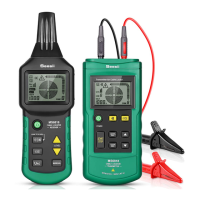Operating instructions for Cable Detector, article 37270766
Page 8 of 34
3. Overview
3.1 Product introduction
When you cut a hole in a wall to install air conditioning, dig a hole in the ground to install a machine, or dig up a
road, you first have to check the location of cables, water pipes and gas lines, to avoid them and prevent
unnecessary problems and hazards. Up until now there was only one way to do this - examining the technical
drawings of the installations concerned. But often these drawings are impossible to find, so you have to hope for
the best and work blind. This can cut cables and pipelines, and lead to power outages, shocks, explosions and even
loss of life.
The cable detector 37270766 sold by our company helps users find cables and lines. You no longer have to just rely
on luck. This cable detector is portable and consists of a transmitter, receiver and some accessory components.
With its modern integrated components and digital circuitry, it is very stable and reliable. The transmitter sends to
the cable (or metal pipe) being searched for an alternating voltage modulated by digital signals. This voltage
generates an alternating field. If you hold the sensor head of the receiver near the field, the sensor generates an
induced voltage. The device amplifies the weak voltage signal several hundred times, and then based on the signal
changes, and after decoding the audio frequency, demodulation and digital processing, shows the position of
hidden cables and pipes as well as their defects on an LCD screen.
The cable detector is user friendly and features pushbutton operation with confirmation by a buzzer. It also has a
visual display, transmitter and receiver with LED lights. The transmitter doesn’t just transfer signals, but also acts as
an AC/DC voltage meter, so that the instrument can show the tested conductor, including AC/DC status and a
warning if a live conductor is tested. The transmitter also has a self-test function that shows on the display if the
transmitter is sending signals, giving the user more certainty when testing. The receiver display is backlit so that
users can see the test results in the dark as well. To improve testing efficiency, the receiver has a loudspeaker that
sounds different tones for different signal intensity levels, so that the user can assess the test results audially for
added convenience. The loudspeaker adapts to loud environments with increased volume. Naturally there is also a
soundless mode for transmitter and receiver to avoid disturbing others. This cable detector is intended for
construction work involving telephone, power and building lines, as well as for maintenance work on these cables
and pipelines.

